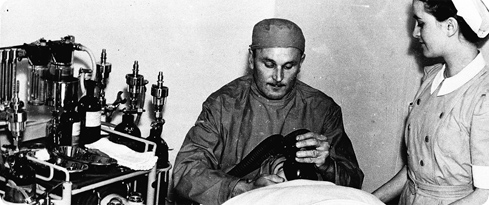Your views

Your feedback is vital to us as we continue to increase the quality of our services.
You are here:
Date: 23 February 2025
Time: 03:49
The Queen Elizabeth Hospital’s role during the Second World War
During the Second World War, the QE’s new facilities were tested to the limit. Patient occupancy at the hospital rose significantly and local inhabitants were treated alongside battle casualties, both civilian and military. The photograph below displays an anaesthetist at work during the war period.

Occupancy at the hospital regularly reached double the figures the building had originally been designed to accommodate. Between 1939 and 1943, patient numbers rose from 3,165 to 12,136. Many local businesses and university buildings were converted to provide extra wards. Ansells Brewery, for example, served as an emergency hospital for air raid casualties until 1945.
Staff shortages made these greater numbers even more difficult for nurses to cope with. Gaps in the medical staff created when individuals enlisted were filled by senior medical students, who generally undertook far more senior duties than would have been usual during times of peace. Other places were filled by outsiders. A neurosurgery department was established under the direction of Mr William Sweet of Boston, who was allocated to the hospital by the Ministry of Health.
At the conclusion of the war, the United Hospitals welcomed back 10 officers to resume their posts after a considerable period of absence. William Sweet, on the other hand, returned to America and was replaced by Professor Brodie Hughes, a full-time surgeon who is remembered for having serviced his complex surgical equipment himself.
Full-time clinical professors were also appointed at this time by the University in the subjects of medicine, surgery, midwifery, and the diseases of women and paediatrics; the work of the professors of medicine and surgery would be based in the QE.
Patient numbers declined slightly in peace-time, with staff treating 6,000 inpatients, 20,000 outpatients and another 48,000 casualties in 1945. On any given day, the QE hospital held nearly 800 inpatients, who, on average, remained in the hospital for 25 days.
The £100,000 deficit in the immediate post-war budget caused hospital administrators particular anxiety, as Government support declined with the conclusion of the Emergency Medical Service.
The majority of the £273,000 received by the hospital in 1945 came from the Ministry of Health (£77,000), while another £33,000 came from paying patients’ fees, substantially more than was raised by donations and subscriptions (£29,000), the backbone of hospital finance in an earlier age.
The majority of expenditure at this time related to salaries and wages, which totalled £170,000. As devoted as staff and administrators were to the voluntary principle, services, which cost £1,000 a day at this time, could not continue without an increase in hospital funding.
An improvement in the financial situation came only in 1948 with the introduction of the National Health Service and the introduction of Government support for all hospitals.
Related pages

Getting here
Information about travelling to, staying at and getting around the hospital.

Jobs at UHB
A great place to work. Learn why.


